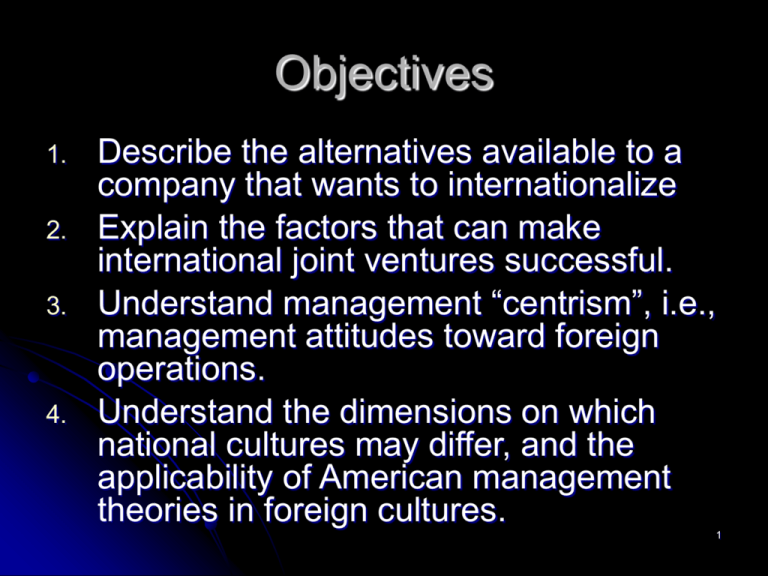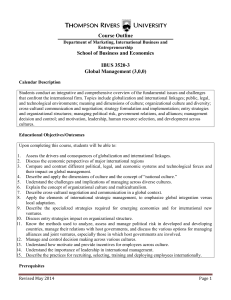Objectives - Kean University
advertisement

Objectives 1. 2. 3. 4. Describe the alternatives available to a company that wants to internationalize Explain the factors that can make international joint ventures successful. Understand management “centrism”, i.e., management attitudes toward foreign operations. Understand the dimensions on which national cultures may differ, and the applicability of American management theories in foreign cultures. 1 International Trade Tariff A tax that government imposes on imported or, occasionally, exported goods. Intended to protect domestic industry and jobs from foreign competition Other countries usually retaliate their own tariffs, actions that eventually reduce the overall amount of trade and impedes economic growth. 2 International Trade Free-Trade Doctrine The idea that if each country specializes in the production of the goods and services that it can produce most efficiently, this will make the best use of global resources If India is more efficient in making textiles, and the United States is more efficient in making computer software, then each country should focus on their respective strengths and trade for the other’s goods. 3 International Trade North American Free Trade Agreement (NAFTA) Abolishes 99% of tariffs on goods traded between Mexico, Canada and the United States Unrestricted cross-border flows of resources Increased investment by U.S. firms in Mexican manufacturing facilities due lower wage costs in Mexico Opportunities and Threats The opportunity to serve more markets Increased competition from NAFTA competitors 4 Distance Culture Markets were essentially closed because of the slowness of communications over long distances. Language barriers and cultural practices made managing overseas businesses difficult Changes in Distance and Communication Improvement in transportation technology and fast, secure communications have greatly reduced the barriers of physical and cultural distances. 5 International Competition Forces Shrinking Globe Air travel Modern information technology Corporate Globalism International Management The pursuit of organizational objectives in international and intercultural settings. 6 Global Organizations for a Global Economy The Internationalization Process Stage I: Licensing Stage 2: Exporting Authorizing companies in foreign countries to produce and/or market a given product within a specified territory in return for a fee. Goods produced in one country are sold to customers in foreign countries. Stage 3: Local warehousing and selling Goods produced in one country are shipped to the parent company’s storage and marketing facilities located in overseas countries. 7 Global Organizations for a Global Economy (cont’d) The Internationalization Process (cont’d) Stage 4: Local Assembly and Packaging Components, rather than finished products, are shipped to company-owned foreign facilities for final assembly and sales. Stage 5: Joint Ventures (also Strategic Alliances or Partnerships) A company in one country pools its resources with another foreign company or companies to create and market products and jointly share profits and losses. 8 Strategic Alliances (Joint Ventures and Strategic Partnerships) Why alliances? Share risks and costs, avoid irreversible resource commitments … faster fit! Explore - Discover new opportunities (e.g., R&D-joint research) Exploit - Increase productivity of current assets (e.g., Marketing-New Market Entry, Manufacturing-Cost Sharing) 9 Strategic Alliances Advantages Facilitate entry into foreign markets. Enable partners to share fixed costs and risks associated with new products and processes. Facilitate transfer of complementary skills between companies. Help establish technological standards. Disadvantages Risk of giving away technological knowhow. Risk of opening local market access to foreign alliance partner. Risk of not getting anything in return. 10 Strategic Alliances (Joint Ventures and Strategic Partnerships) Recommendations for Achieving Success 1. 2. Be very clear about the alliance’s purpose Select partners to minimize risk: 1. 2. 3. 3. 4. partner capability trust/reputation you & partner’s current/future competitive position Agree on ground rules about the rights and responsibilities of all parties at the outset Structure the alliance based on alliance 11 Structure Alliances to Reduce Risk “Walling off” 12 Global Organizations for a Global Economy (cont’d) The Internationalization Process (cont’d) Stage 6: Direct Foreign Investment The production and marketing of products through a wholly owned subsidiary in a foreign country. 13 From Global Companies to Transnational Companies Global Company A multinational venture centrally managed from one country. Has global strategies for product design, financing, purchasing, manufacturing, and marketing. Transnational Company A global network of productive units with a decentralized authority structure and no distinct national identity. Relies on a blend of global and local strategies. 14 Toward Greater Global Awareness and Cross-Cultural Competence Travelers: Engage in short-term visits to foreign countries. Have limited knowledge of local history, culture, and customs. Have limited local language skills. Don’t attempt to adapt to the local environment. Settlers Take assignments lasting up to five years. Have in-depth insights into the host country’s history, customs, and culture. Speak the local language well or fluently. Are culturally-trained 15 to “go native.” Contrasting Attitudes Toward International Operations Ethnocentric Polycentric The view that assumes the home country’s personnel and ways of doing things are best. The view that assumes local managers in host countries know best how to run their own operations. Geocentric A world-oriented view that draws upon the best talent from around the world. 16 The Cultural Imperative Culture A population’s taken-for-granted assumptions, values, beliefs, and symbols that foster patterned behavior. Cultural Profile of American Managers Positive: Informal, creative, open-minded Negative: Educationally and professionally narrow 17 The 3 levels of Culture (Schein) 1. Artefacts and creations - the things one can see, hear and observe. Dress codes Patterns of behaviour, Physical symbols Organizational ceremonies Office layout 18 The 3 levels of Culture (Schein) 2. Values and Beliefs –can be identified from stories language symbols how people explain justify what they do 19 The 3 levels of Culture (Schein) 3. Basic assumptions – beliefs so deeply embedded in a culture that members are no longer consciously aware of them. 20 LEVELS OF CULTURE Cultural artefacts (eg. fashion, popular culture) Language and Verbal Symbols Nonverbal Symbols Symbolic Meanings Cultural Norms Cultural Values Cultural Beliefs Cultural Traditions We can see and hear We cannot see; these are hidden Universal Human needs Ting-Toomey, 1999 21 SOURCES OF ORGANIZATIONAL CULTURE the national culture (Hofstede, 1991) the vision, management style and personality of the founder or other significant dominant managers (Schein, 1985) the nature of the business, the type of products and the environment within which the organisation operates (Gordon, 1991) 22 National cultures (Hofstede) Hofstede researched 40 countries in terms of national cultures in work He determined 4 dimensions of difference in national cultures Power distance Uncertainty avoidance individualism Masculinity 23 POWER DISTANCE Dependence relationships in a country Small power distance Limited dependency of subordinates on bosses Consultative style of decision making High Power Distance countries: Latin countries (France, Spain, Latin America), Asian and African countries Low Power Distance countries: USA, UK, Netherlands, Scandinavian countries 24 Power Distance in Organizations LOW HIGH Decentralization popular Narrow salary range Consultative decision making Hierarchical organizations Centralization Wide salary range Subordinates expect rules 25 Uncertainty avoidance This is a measure of the degree to which people are willing to accept change and work in uncertain circumstances. The higher the degree of uncertainty avoidance the more structured people like things to be. Examples: Low= Sweden, High = France 26 Individualism and collectivism This refers to degree to which people see themselves as being part of a group or as individuals. Examples include for individualistic= USA, UK, Australia Examples for Collectivist= Norway, Japan 27 Masculinity/ femininity Masculine cultures place a high value on things like Heroism, success, achievement, Leading. Feminine cultures place a high value on groups, quality of life, caring. Examples- Masculine= Germany, USA Feminine= Sweden, Denmark, Finland 28 Culture (cont’d) High-Context Cultures Cultures in which nonverbal and situational messages convey primary meaning (e.g. Japan). Status of an individual is important in determining relationships. Low-Context Cultures Cultures in which words convey primary meaning (e.g., UK). Nonverbal messages are secondary to spoken words. The terms of the deal are more important building 29 a business relationship. Culture (cont’d) Other Sources of Cultural Diversity (cont’d) Time Monochronic time: a perception of time as a straight line broken into standard units. Timely arrivals and keeping appointments is considered important. Polychronic time: a perception of time as flexible, elastic, and multidimensional. Appointment schedules are considered approximations and are not kept precisely. 30 Culture (cont’d) Other Sources of Cultural Diversity (cont’d) Interpersonal space Some cultures prefer a close rather than wide distance between conversing individuals. Language skills Language fluency opens insights into another culture. Religion Religion has many effects on personal and professional activities in many cultures. 31 Ouchi’s Theory Z: The Marriage of American and Japanese Management Theory Z Organizations Organizations that successfully combine the traits of typical American and Japanese companies. Successful geocentric managers are not prisoners of their own culture. American qualities – Emphasis on individual responsibility Japanese-like qualities – – – – – – Long-term employment Slower promotions Cross-functional career paths Emphasis on self-control Participative decision making Concern for employees 32 A Cross-Cultural Study of Work Goals Findings’ implications Managers need to adapt the motivation programs to local preferences. An international contingency approach to motivation is called for. 33 An International Contingency Model of Leadership Model’s Assumptions/Guidelines Leadership must be adapted to the local culture. Participative leadership is the most applicable style where workers trust their leader. Directive leadership is considered the least appropriate style of leadership. 34 Staffing Foreign Positions Why Is the U.S. Expatriate Failure Rate So High? Sink-or-swim approach taken by companies in not preparing managers for foreign assignments. Family and personal adjustment problems that arose after arriving in the foreign assignment. 35 Cross-Cultural Training Cross-Cultural Training A guided experience that helps people live and work in foreign cultures. Specific Training Techniques Documentary programs to familiarize expatriate with assignment destination. Culture assimilator exposed expatriate to simulated intercultural incident and situations. Language instruction builds the expatriate’s conversational skills in a foreign language. 36 Cross-Cultural Training (cont’d) Specific Training Techniques (cont’d) Sensitivity training provides experiential exercises to teach expatriates to be aware of the impact of their actions on others in another culture. Field experiences provide firsthand exposure to ethnic subcultures that heightens expatriates’ cultural awareness. 37 Cross-Cultural Training (cont’d) Conclusions A combination of documentary and interpersonal training is the best combination for expatriates. Provide orientation for both expatriate and family. Have family sponsors or assigned mentors available at the foreign assignment. Repatriation is an importance part of the entire foreign assignment experience. 38 North American Women on Foreign Assignments Women are above-average in being successful in foreign assignments. Strongest barriers to foreign assignments has been self-disqualification and the prejudice of home country managers. Culture is a bigger hurdle than gender: women on foreign assignments are seen as North Americans first, then women. 39 Relying on Local Management Advantages of Using Foreign Nationals They know the language and culture. They do not require huge location expenses. Host governments favor more local control. Disadvantage Local managers may not be attuned to homeoffice goals and procedures. 40







